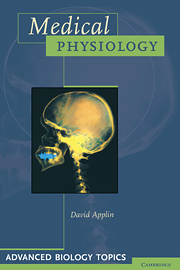Book contents
- Frontmatter
- Contents
- 1 What is disease?
- 2 Understanding the immune system
- 3 The control of bleeding
- 4 Heart disease
- 5 Physiological effects of exercise
- 6 Food and health
- 7 Diseases of the gaseous exchange system
- 8 Kidney failure
- 9 Fertility and contraception
- 10 The brain: memory, ageing and the effects of drugs
- 11 Medical genetics
- 12 Biotechnology and medicine
- Index
- Frontmatter
- Contents
- 1 What is disease?
- 2 Understanding the immune system
- 3 The control of bleeding
- 4 Heart disease
- 5 Physiological effects of exercise
- 6 Food and health
- 7 Diseases of the gaseous exchange system
- 8 Kidney failure
- 9 Fertility and contraception
- 10 The brain: memory, ageing and the effects of drugs
- 11 Medical genetics
- 12 Biotechnology and medicine
- Index
Summary
Disease and good health are two sides of the same coin – how well we feel. A healthy person feels well because all parts of the body are working efficiently. Disease disrupts normal bodily functions and makes a person feel ill. A feeling of wellness is not just the absence of illness. Wellness includes mental health as well as bodily health – both are part of the equation defining good health.
The human body is an ideal environment for a range of organisms that cause different diseases. Bacteria are blamed for most human ailments, but viruses are also important disease-causing agents. Protists, fungi and different animal parasites also cause disease as a result of their activities inside our bodies.
Disease-causing organisms are called pathogens. Diseases are said to be infectious (communicable) if the organisms can be passed from one person to another. Not all diseases are infectious. Many non-infectious diseases develop because the body is not working properly. Increasing age and the way we treat our bodies affect the onset of non-infectious diseases. Many disorders can be avoided or at least delayed by changing our life-style.
Infectious diseases
During the nineteenth century the population of Britain more than trebled. People in search of work flocked to the cities, which were growing fast in the wake of the Industrial Revolution. London was typical of the times. With no proper means of waste disposal or sanitation, London's teeming population piled household rubbish and excrement outside the home.
- Type
- Chapter
- Information
- Medical Physiology , pp. 1 - 21Publisher: Cambridge University PressPrint publication year: 1997



